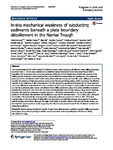In-situ mechanical weakness of subducting sediments beneath a plate boundary décollement in the Nankai Trough
| dc.contributor.author | Hamada, Y | |
| dc.contributor.author | Hirose, T | |
| dc.contributor.author | Ijiri, A | |
| dc.contributor.author | Yamada, Y | |
| dc.contributor.author | Sanada, Y | |
| dc.contributor.author | Saito, S | |
| dc.contributor.author | Sakurai, N | |
| dc.contributor.author | Sugihara, T | |
| dc.contributor.author | Yokoyama, T | |
| dc.contributor.author | Saruhashi, T | |
| dc.contributor.author | Hoshino, T | |
| dc.contributor.author | Kamiya, N | |
| dc.contributor.author | Bowden, S | |
| dc.contributor.author | Cramm, M | |
| dc.contributor.author | Henkel, S | |
| dc.contributor.author | Homola, K | |
| dc.contributor.author | Imachi, H | |
| dc.contributor.author | Kaneko, M | |
| dc.contributor.author | Lagostina, L | |
| dc.contributor.author | Manners, Hayley | |
| dc.contributor.author | McClelland, HL | |
| dc.contributor.author | Metcalfe, K | |
| dc.contributor.author | Okutsu, N | |
| dc.contributor.author | Pan, D | |
| dc.contributor.author | Raudsepp, MJ | |
| dc.contributor.author | Sauvage, J | |
| dc.contributor.author | Schubotz, F | |
| dc.contributor.author | Spivack, A | |
| dc.contributor.author | Tonai, S | |
| dc.contributor.author | Treude, T | |
| dc.contributor.author | Tsang, MY | |
| dc.contributor.author | Viehweger, B | |
| dc.contributor.author | Wang, DT | |
| dc.contributor.author | Whitaker, E | |
| dc.contributor.author | Yamamoto, Y | |
| dc.contributor.author | Yang, K | |
| dc.contributor.author | Kinoshita, M | |
| dc.contributor.author | Maeda, L | |
| dc.contributor.author | Kubo, Y | |
| dc.contributor.author | Morono, Y | |
| dc.contributor.author | Inagaki, F | |
| dc.contributor.author | Heuer, VB | |
| dc.date.accessioned | 2018-11-09T21:32:42Z | |
| dc.date.issued | 2018-11-03 | |
| dc.identifier.issn | 2197-4284 | |
| dc.identifier.issn | 2197-4284 | |
| dc.identifier.other | 70 | |
| dc.identifier.uri | http://hdl.handle.net/10026.1/12742 | |
| dc.description.abstract |
© 2018, The Author(s). The study investigates the in-situ strength of sediments across a plate boundary décollement using drilling parameters recorded when a 1180-m-deep borehole was established during International Ocean Discovery Program (IODP) Expedition 370, Temperature-Limit of the Deep Biosphere off Muroto (T-Limit). Information of the in-situ strength of the shallow portion in/around a plate boundary fault zone is critical for understanding the development of accretionary prisms and of the décollement itself. Studies using seismic reflection surveys and scientific ocean drillings have recently revealed the existence of high pore pressure zones around frontal accretionary prisms, which may reduce the effective strength of the sediments. A direct measurement of in-situ strength by experiments, however, has not been executed due to the difficulty in estimating in-situ stress conditions. In this study, we derived a depth profile for the in-situ strength of a frontal accretionary prism across a décollement from drilling parameters using the recently established equivalent strength (EST) method. At site C0023, the toe of the accretionary prism area off Cape Muroto, Japan, the EST gradually increases with depth but undergoes a sudden change at ~ 800 mbsf, corresponding to the top of the subducting sediment. At this depth, directly below the décollement zone, the EST decreases from ~ 10 to 2 MPa, with a change in the baseline. This mechanically weak zone in the subducting sediments extends over 250 m (~ 800–1050 mbsf), corresponding to the zone where the fluid influx was discovered, and high-fluid pressure was suggested by previous seismic imaging observations. Although the origin of the fluids or absolute values of the strength remain unclear, our investigations support previous studies suggesting that elevated pore pressure beneath the décollement weakens the subducting sediments. [Figure not available: see fulltext.]. | |
| dc.format.extent | 70- | |
| dc.language | en | |
| dc.language.iso | en | |
| dc.publisher | SpringerOpen | |
| dc.subject | Plate boundary decollement | |
| dc.subject | Nankai Trough | |
| dc.subject | Excess fluid pressure | |
| dc.subject | Equivalent strength | |
| dc.subject | Drilling parameters | |
| dc.subject | International Ocean Discovery Program (IODP) | |
| dc.subject | Temperature-Limit of the Deep Biosphere off Muroto (T-Limit) | |
| dc.subject | Site C0023 | |
| dc.subject | DV Chikyu | |
| dc.title | In-situ mechanical weakness of subducting sediments beneath a plate boundary décollement in the Nankai Trough | |
| dc.type | journal-article | |
| dc.type | Journal Article | |
| plymouth.author-url | https://www.webofscience.com/api/gateway?GWVersion=2&SrcApp=PARTNER_APP&SrcAuth=LinksAMR&KeyUT=WOS:000462215600001&DestLinkType=FullRecord&DestApp=ALL_WOS&UsrCustomerID=11bb513d99f797142bcfeffcc58ea008 | |
| plymouth.issue | 1 | |
| plymouth.volume | 5 | |
| plymouth.publication-status | Published | |
| plymouth.journal | Progress in Earth and Planetary Science | |
| dc.identifier.doi | 10.1186/s40645-018-0228-z | |
| plymouth.organisational-group | /Plymouth | |
| plymouth.organisational-group | /Plymouth/Faculty of Science and Engineering | |
| plymouth.organisational-group | /Plymouth/Faculty of Science and Engineering/School of Geography, Earth and Environmental Sciences | |
| plymouth.organisational-group | /Plymouth/REF 2021 Researchers by UoA | |
| plymouth.organisational-group | /Plymouth/REF 2021 Researchers by UoA/UoA07 Earth Systems and Environmental Sciences | |
| plymouth.organisational-group | /Plymouth/Users by role | |
| plymouth.organisational-group | /Plymouth/Users by role/Academics | |
| dcterms.dateAccepted | 2018-10-09 | |
| dc.rights.embargodate | 2019-12-18 | |
| dc.identifier.eissn | 2197-4284 | |
| dc.rights.embargoperiod | Not known | |
| rioxxterms.versionofrecord | 10.1186/s40645-018-0228-z | |
| rioxxterms.licenseref.uri | http://www.rioxx.net/licenses/all-rights-reserved | |
| rioxxterms.licenseref.startdate | 2018-11-03 | |
| rioxxterms.type | Journal Article/Review |


